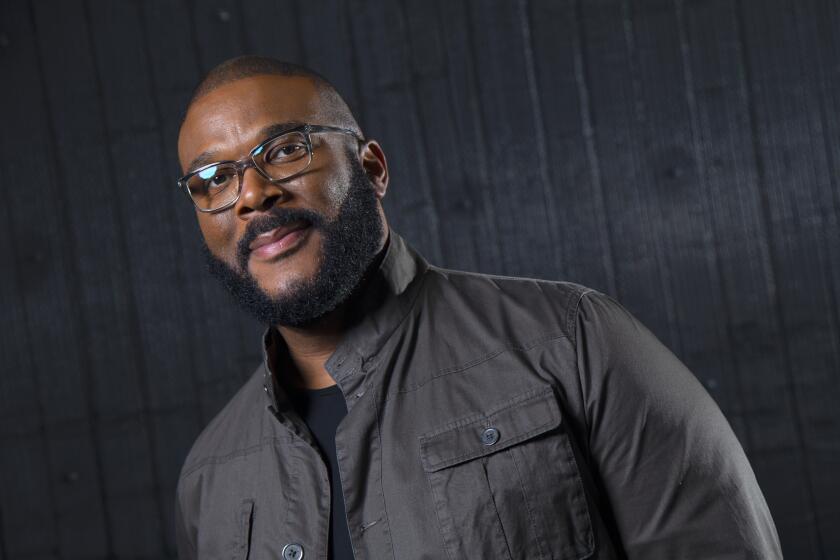An Artist Films Her Take on Horror Genre
- Share via
Just as there’s no accounting for taste, there’s no accounting for artists. If Michelangelo or Van Gogh were alive today, would they be making art films?
Maybe. But how about horror films? Or, to take the ludicrous one step further, how about horror-film sendups?
Andy Warhol is perhaps the most famous, though not the first, contemporary artist to shoot a whole lot of film.
Long before the Pop-meister turned on a camera, Salvador Dali collaborated on movies with Luis Bunuel, and Jean Cocteau made them with Rene Clement.
More recently, three art-world superstars of the 1980s--Julian Schnabel, David Salle and Robert Longo--temporarily hocked their easels for director’s chairs.
Now Cindy Sherman, the performance artist whose postmodern signature has been impersonations of stereotypes from B movies, has gotten into the Hollywood game with “Office Killer,” a purported satire of the exploitation-horror genre. It opens Friday at the Port Theatre (2905 E. Coast Highway, Corona del Mar. $4.50-$7. [714] 673-6260).
While film critics regard “Office Killer” with mixed to negative feelings--the reviewer for The Times said it “never rises above anemic homage” to the horror genre--art critics take a more sanguine view.
Amada Cruz, co-curator of the “Cindy Sherman Retrospective” currently at the Museum of Contemporary Art in Los Angeles, writes in the exhibition catalog that “Office Killer” brings the artist’s career “full circle” from the early works of the late 1970s that first gained Sherman recognition: “Untitled Film Stills.”
In those, described by Cruz as “a photographic record of self-performances,” Sherman cast herself as various anonymous women who might be found in old, unspecified film-noir movies. By directing “Office Killer,” she gets others to play a very specific drama. “The film is about a magazine editor, Dorine, who accidentally kills an office worker,” Cruz notes. “As more murder ensues, Dorine begins to bring home the bodies. In a scenario familiar to Sherman”--setting up all sorts of grotesque tableau for the camera--”Dorine [becomes] a stand-in for Sherman and another of her self-transformations.”
Movies in the name of art have run the gamut from Warhol’s soporific “Sleep” (a shot of poet John Giorno asleep for many hours) to underground filmmaker Stan Brakhage’s kaleidoscopic “Dog Star Man” (hand-painted frames of film to represent every kind of retinal imagery, including closed-eye vision).
So who’s to say that “Office Killer” won’t make Sight & Sound’s “Greatest Films of All Time” list when it comes out next in 2002?
The last time the authoritative British film magazine took its worldwide poll of cineastes and critics--in 1992--Stanley Kubrick’s “2001: A Space Odyssey” was on it. Have you seen “2001” lately? In a word: Ugh.
*
In L.A. and beyond:
With his 9 1/2-hour “Shoah,” Claude Lanzmann accomplished the seemingly impossible: He brought such beauty to his recounting of the horror of the Holocaust that he made it accessible and comprehensible. Rarely screened because of its formidable length, the monumental 1985 film will be the final offering in the American Cinematheque’s “Really Long Film Series” at Raleigh Studios in Hollywood. Part I screens Saturday at 7:15 p.m., and Part II Sunday at 6:15 p.m.
“Shoah” is not only a document of incalculable historical importance but also a great work of art. It stands as a testament to the human spirit and its capacity to endure in the face of an evil of such a diabolical nature and immensity of scale as to be without precedent. So inspired a filmmaker is Lanzmann that he makes the unbearable bearable, and in doing so, offers the catharsis of classic tragedy. Suspenseful and compelling, “Shoah” is the ultimate mystery movie, its quest no less than an attempt to illuminate the darkest depths of the human soul. “Shoah”--”annihilation” in Hebrew--contains no archival footage or stills of the Holocaust and its victims.
Focusing on the Nazi extermination centers of Poland, Lanzmann--a veteran French journalist--interviews the precious few survivors of those camps, their administrators and those who lived near these rural sites. As Lanzmann’s conversations with his subjects continue, his camera begins to survey what remains of the damnably picturesque locales where these terrible events took place less than half a century ago.
It is “Shoah’s” supremely inspired construction that makes it so mesmerizing and permanently haunting. The key is the deeply involving tension “Shoah” develops through simultaneous expansion and contraction. “Shoah” is circular: It starts calmly, introducing us to places and people, proceeding to the next locale and the next set of individuals, and on and on, but then it begins returning again and again to the same sites and same speakers. Gradually, we become aware that as “Shoah” increases its cast of witnesses, its roster of crimes against humanity ever lengthening and the geographical distances it covers ever growing, it also is relentlessly tightening, probing deeper and deeper into the emotions and memories of its subjects.
“Shoah” could scarcely be a more eloquent reminder that anything is permissible once one group of people starts regarding another as less than human. Significantly, Jewish corpses were referred to as “pieces” and “figuren,” which translates as puppets or dolls.
“Shoah” gives immediacy to a catastrophic event that many would prefer not to remember having happened in the first place. On the printed page, the witnesses’ testimony can become unbearably painful to read, but on the screen “Shoah” is so powerful, so overwhelming an experience, you never wish to stop listening or to look away. (213) 466-FILM.
*
Jean-Pierre and Luc Dardenne’s “La Promesse,” which was voted best foreign film of the year by the Los Angeles Film Critics Assn., returns for 11 a.m. Saturday and Sunday screenings at the Monica 4-Plex in Santa Monica. “La Promesse” is the story of a 15-year-old youth (Jeremie Renier) torn between his devotion to his father and his sense of what is right. (310) 394-9741.
Kevin Thomas reviewed “Shoah” for The Times in 1985. This column contains excerpts of that review.
More to Read
The biggest entertainment stories
Get our big stories about Hollywood, film, television, music, arts, culture and more right in your inbox as soon as they publish.
You may occasionally receive promotional content from the Los Angeles Times.










